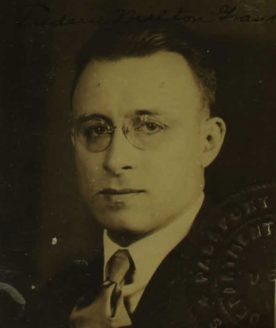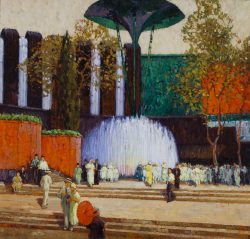Frederic M. Grant, from a photograph on passport application dated 1922 (www.ancestry.com).

Frederic M. Grant 1886–1959
Born in Sibley, Iowa, Frederic Milton Grant early demonstrated a talent for music as well as art. He abandoned studies in architecture to enroll in the Art Institute of Chicago, with additional training at the Chicago Academy of Fine Arts (founded in 1902). Grant worked as a commercial artist to fund study abroad, in Italy in 1907 with American impressionist painter William Merritt Chase, followed by training at the Académie Colarossi in Paris; while there, he occasionally supported himself as a piano player. He then studied under Henry Snell in Gloucester, Massachusetts, and spent a season with Chase in Carmel, California. By 1915, Grant was back in Chicago. That year, he won first prize for a group of paintings in the annual show of the Art Students’ League of Chicago and debuted in the Art Institute’s exhibitions for American artists and for artists of Chicago. Within a few years, Grant had established himself as a decorative painter with a reputation as a brilliant colorist. His landscapes, figural images, still lifes, and genre scenes were influenced by the jewel-like surfaces of the pre-impressionist French painter Adolphe Monticelli, the heightened color of Claude Monet, and the geometrically structured compositions of Paul Cézanne. In the 1920s, Grant made a particular specialty of exotic and romanticized historical subjects, many inspired by his travels. In 1922–1923, he returned to Europe, spending most of his time in Italy, and in 1928 he went around the world, sketching in the Pacific Islands, East and Southeast Asia, and the Middle East.
Grant taught and exhibited actively in Chicago. Beginning in 1919 he was a resident of the Tree Studios building on the Near North Side, where he joined a community of more-conservative artists. Grant had solo exhibitions at the Carson Pirie Scott and Company department store galleries and Anderson Galleries, and he won several prizes in the Art Institute’s annual shows. Lauded by the Chicago Tribune’s critic Eleanor Jewett as an artist “undisturbed by the muddy tumult of modernism,” he also won the respect of Clarence J. Bulliet, a champion of modernism, who profiled Grant in 1936 in his series “Artists of Chicago” in the Chicago Daily News.i In the following years, Grant was less visible in the local art scene. After World War II he moved to the Los Angeles area (where his parents had settled earlier) and began painting abstract works inspired by musical compositions.
Wendy Greenhouse, PhD
i Eleanor Jewett, “Fred. M. Grant, Great Colorist, Critic Declares,” Chicago Tribune, June 4, 1930.
